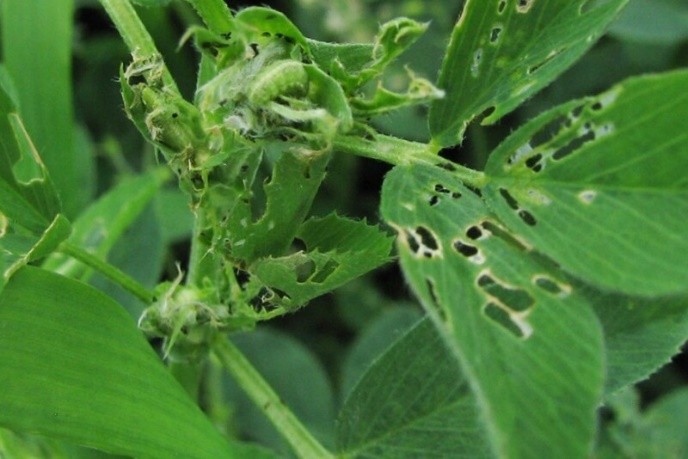
Mar 4, 2025, 11:00 AM
Managing Alfalfa Weevil Infestation
Situation Overview
Alfalfa weevils typically hatch in early spring from eggs they overwinter in the field, entering the larval stage after accumulating 200–250 Growing Degree Units (GDUs). This usually occurs around mid-May, although timing can vary by location. The most significant damage occurs during the larval and pupal stages, not the adult weevil stage. As temperatures rise, the adult weevils become dormant, leaving the larvae and pupae to cause severe damage to alfalfa crops. Weevils can completely defoliate a field, leaving only the veins behind in the leaves, creating a skeleton-like appearance.
Alfalfa Weevil Life Cycle and Impact
The weevils damage the alfalfa crop by feeding on the leaf tissue, while leaving the veins intact. This results in significant defoliation, especially when infestations are large. The damage is most severe during the larval and pupal stages, which typically occur during the first cutting season.
 Factors to Consider
Factors to Consider
When managing alfalfa weevils, consider the following factors:
- Timing of weevil emergence in relation to the alfalfa growth cycle.
- The cutting schedule for your alfalfa crop.
- The extent of defoliation caused by the weevils.
- The overall quality of the alfalfa crop.
 Action Plan
Action Plan
- Scouting: Begin scouting when 250 GDUs have accumulated, which is when weevil eggs typically hatch and larvae become active. During your scouting, note the following:
- The growth stage of the alfalfa (pre-bud, bud, flowering).
- The length of the alfalfa stems.
- The percentage of leaf tip feeding.
- Treatment: Insecticide application is usually the recommended treatment for alfalfa weevils. However, if infestation is close to the cutting period (within five days), treatment may not be necessary. In this case, cutting the crop may be sufficient to control the weevils. Scouting should continue after cutting to ensure that the infestation has been managed and that re-infestation does not occur.
Summary
Alfalfa weevil damage is most common in late spring, particularly during the first cutting of alfalfa, when the larvae and early pupae stages are most active. Weather conditions significantly impact the severity of the damage, with cool, wet conditions often reducing weevil populations or making them less harmful. Although alfalfa weevils can cause significant damage, they are relatively easy to monitor and manage with appropriate treatment strategies if an infestation occurs.
Resources for Further Information
- Purdue University Extension: Alfalfa Weevil Information
Heat Unit-Based Treatment Guidelines
- 250 GDU: Start sampling.
- 300 GDU: If tip feeding is 0–40%, reevaluate in 7-10 days or treat immediately if there are 3+ larvae per stem and feeding is above 50%.
- 400 GDU: If tip feeding is 60%, treat immediately.
- 500 GDU: If tip feeding is 75%, treat immediately.
- 600 GDU: If tip feeding exceeds 75%, treat immediately.
- 750 GDU: If cutting is delayed more than 5 days, treat immediately.
- Post-Harvest (750 GDU): If no regrowth and weevil larvae are present, or if 50% of stubble shows feeding damage, treat within 4-5 days of cutting.
These guidelines help determine the appropriate timing for treatment based on weevil activity and crop growth stage.

